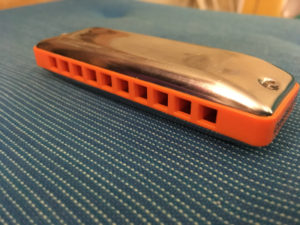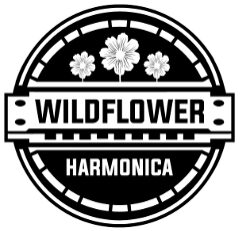 I recently got a diminished-tuned diatonic harmonica from Seydel, using their custom tuning service, and it’s really fun and logical.
I recently got a diminished-tuned diatonic harmonica from Seydel, using their custom tuning service, and it’s really fun and logical.
The Bad News
“Wait, this harmonica doesn’t work!” If you just blow and draw, nothing sounds good. In Diminished Tuning, you have to be conscious of your scale pattern, and you’ll have to play lots of half-step bends. Also, a ten hole harp doesn’t quite cover three octaves in Diminished Tuning, so you either have to live with reduced range, or get a 12-hole model.
The Good News
In Diminished Tuning, for each scale and lick, there are only 3 breath patterns, and the only bends required are small, half-step draw bends. This approach will cover you for all 12 keys. If you’re a minimalist and only want to carry one blues harp, Diminished Tuning is extremely attractive. Especially if you love playing melodies and improv that don’t fit easily on a Richter-Tuned harp.
Moveable Shapes
The three patterns are based on the location of the tonic note: there’s one pattern that starts on the blow, one pattern that starts on the draw, and one pattern that starts on the draw bend. Playing by ear is easy, just find the tonic note and ask yourself, “Is this a blow, a draw, or a draw bend?” then play the pattern that matches.
Here are some examples, starting at Hole 1, but which can be moved to any other hole with the same relationships.
Major Pentatonic Scale
Blow Position
_____________________ Draw Note |X|_|_|_|_|_|_|_|_|_| Draw Bend |_|X|X|_|_|_|_|_|_|_| Blow Note |X|_|_|X|X|_|_|_|_|_|
Draw Bend Position
_____________________ Draw Note |_|X|X|_|_|_|_|_|_|_| Draw Bend |X|_|_|X|X|_|_|_|_|_| Blow Note |_|X|_|_|_|_|_|_|_|_|
Draw Position
_____________________ Draw Note |X|_|_|X|X|_|_|_|_|_| Draw Bend |_|X|_|_|_|_|_|_|_|_| Blow Note |_|_|X|X|_|_|_|_|_|_|
Note Layout
Here are the notes, if you started with a C on 1 blow. Notice that every blow and draw are a whole step apart, with a half-step bend available in between. Simply by playing blow, draw-bend, draw, you get a full chromatic scale.
Draw Note D F Ab B D F Ab B D F Draw Bend Db E G Bb Db E G Bb Db E Blow Note C Eb Gb A C Eb Gb A C Eb Hole # 1 2 3 4 5 6 7 8 9 10
Is This The End of Overblows?
Rest assured, I’m not abandoning standard Richter tuning and the overblow approach to chromaticity. Mainly because I’m used to it, but also because I like the deeper bends on holes 2, 3 and 10, I like the full three octave range on 10 holes, and I like the direct connection to the playing of great players of the past. Plus, standard tuning plays in a single primary key MUCH more easily than diminished tuning does.
But I really like the logic and ease of play of diminished tuning, especially for covering all keys and scale types on a single 10-hole blues harp. Yes, practice is required to get good intonation on the half-step draw bends, and the interval relationships from hole to hole are new.
But even after just a week, I’m confident that I actually could play a whole pop-rock gig with just one diminished harp. I’d have to keep things simple, but I think I could do it. I mean, heck, it’s just three patterns. Find the tonic note, and go!
Where to Get One?
I retuned an old Hohner Blues Harp for my first experiments, then ordered one custom tuned from Seydel, using their Harp Configurator. It cost about $80 and took about three weeks to ship from Germany. Another option would be to reach out to a domestic harmonica technician near you and request a quote for retuning.
